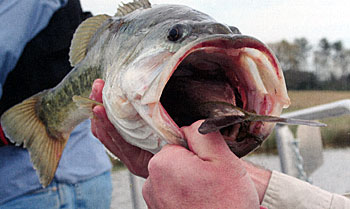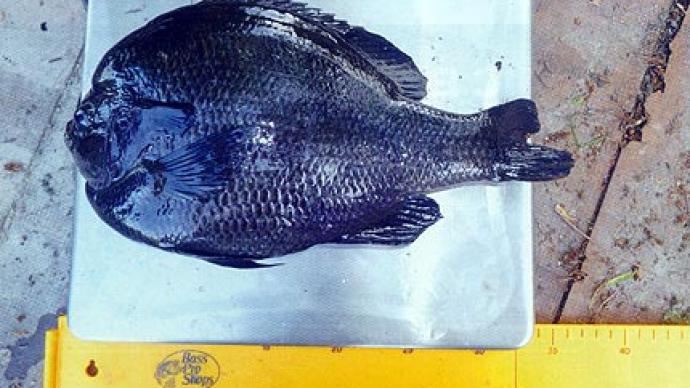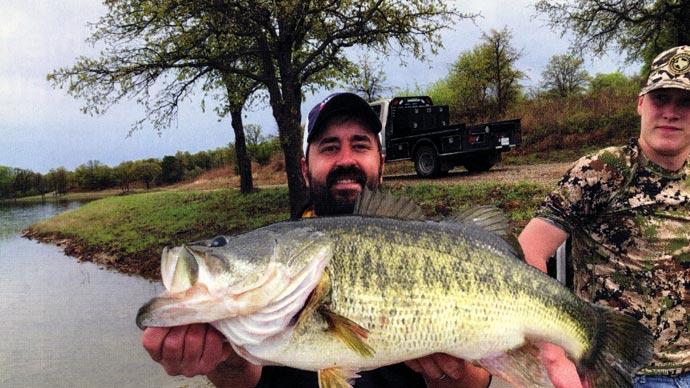
When I took genetics in college, it was like learning a foreign language. I was absolutely certain that the professor was speaking Portuguese. It wasn't until graduate school that genetics finally started to make sense, especially when I put it in the context of something I cared about—fish. In this edition of Empirically Speaking, we'll discuss some key genetic issues as they relate to largemouth bass management in your private fishing lake, and hopefully it won't sound like Portuguese.
Bass genetics are always a hot topic with lake managers. Usually the discussions involve selection of species or strain, like "should I stock Florida bass or northern bass?" or "is the Ft hybrid bass a good idea?" However, these questions do not always have a simple yes or no answer because genetic effects are relatively subtle. Sure, genetic effects may be obvious, such as when all of your precious Florida bass die under ice cover, but they are usually gradual, such as years of inbreeding leading to slow growth and reduced survival, fish that are more difficult to catch, or increasing occurrence of deformities and lower disease resistance.
When it comes to management for trophy bass fishing, fast growth and maximum size potential are primary considerations. There are four main factors that affect how large a fish will grow. First is water temperature, which determines the growing season for fish. All fish species have an optimum temperature for growth. When water temperature is too cold, fish grow slowly; when water is too warm, fish grow slowly; when water is excessively hot, fish will actually lose weight or die. Second is food quantity and quality. The more high-energy food a fish can eat, the faster it will grow. Third is age. The more time a fish has to grow, generally the larger it will become. Finally, we come to genetics. Genetics can influence how fish respond to temperature, how they convert food, and even how long they live, so genetics can be very important in pond management.
Most pondmeisters know that largemouth bass come in several genetic varieties. These are the northern bass, which is native to most of the eastern and central United States, and the Florida bass, native to the subtropical peninsula of Florida. There is considerable debate on whether Florida bass and northern bass are separate species or simply closely related subspecies, but for this article I will consider them separate species. There are also crosses between these two species. These crosses occur naturally from southern Mississippi to Southern Georgia and northern Florida where the two species overlap. These mixed populations vary considerably in the percentages of northern and Florida genetics they contain, because centuries of interbreeding have mixed up the gene pool. These fish are usually referred to as intergrades. However, many fish hatcheries produce and sell a true hybrid, which is half Florida, half northern bass. Some hatcheries use trade names like tiger bass and super bass, but this cross is generally known as an F, hybrid bass because it is a first generation cross between the two species. So which bass is best?
Each species and their hybrid have its pros and cons. Florida bass grow the largest at southern latitudes, but are much less tolerant of cold water than northern bass. This means they will die at temperatures that are easily survived by northern bass, so it doesn't make much sense to stock a lake in Wisconsin with pure Florida bass that will likely die under the winter ice. Northern bass do not grow as large as Florida bass in warmer climates. In fact, most of the largest bass caught generally have all or mostly all Florida bass genetics. However, some research and angler reports suggest that Florida bass are more difficult to catch than northern bass, so what good is a big fish if you can't catch it? Northern bass live longer in cooler climates than Florida bass, and Florida bass tend to live longer than northern bass in warmer climates. Lifespans decrease in general from north to south for both species.

First generation (F1) hybrids between these two tend to exhibit the benefits of both species— good growth, cold tolerance, and relatively easy to catch. This is called hybrid vigor. Here's a simplified explanation for how hybrid vigor works. Like all living things, the genetics of a fish controls almost everything about it, including appearance, growth potential, reproduction, and even behavior. These "instructions" are stored on chromosomes, with each trait controlled by a specific gene or group of genes on the chromosome. There are two copies of each chromosome, and thus there are two genes or groups of genes for each trait. However, there are often different versions of each gene on each chromosome, called alleles. When pure Florida and pure northern bass spawn together, their offspring receive one allele from each species for each trait. Often the best allele is dominant, and will mask the effects of the less desirable allele. Sometimes, the two different alleles working together are superior to either allele working alone. Thus, the F1 hybrids initially stocked in a lake often have the best of both species.
The downside to hybrid bass is that they will spawn after 2-3 years, creating an F2 generation (two F1 parents spawn together). There is no guarantee that their offspring will have the same hybrid vigor because of the random reorganization that occurs during mating. Basically, the alleles get all jumbled up. In some cases a phenomenon called outbreeding depression can occur, which is the expression of negative traits such as slower growth, reduced survival, or low spawning success. This can potentially get worse each successive generation. As F, and F2 generations continue to interbreed, the lake ends up with a bunch of Fx generation bass (mixture of different generations), with genetics that are likely to be less well adapted compared to the F1 hybrid or either parent species. This may cause slow growth, greater disease susceptibility, or other effects that are counterproductive to big bass management. This is the reason vegetable farmers love to grow F1 hybrid crops—because they grow large, but they never use the F, generation for further breeding of F2 or Fx generation crops. There are simply too many unpredictable genetic combinations produced.
If you have F1 hybrids in your lake, don't freak out! Fish management, including proper harvest, fertilization, and prey supplementation usually outweighs genetics when it comes to growing big bass. And of course some of the offspring should randomly get just the right genetic combination to show the best traits. In fact, given where George Perry's world record bass was caught in Georgia, this fish almost certainly was an intergrade Fx bass! But the proportion of fish showing the best traits will likely decrease in each successive generation. So trophy potential may decline, but it never fully goes away.
There are some things you can do to maximize success with F1 hybrids and avoid outbreeding depression. Apart from intensively managing population size and food production, probably the best advice is to remove every F2 or Fx bass caught, and periodically restock with new F1 hybrids. Although time consuming, marking every F1 fish at stocking with a fin clip will make this much easier. This approach will ensure that there are always some F1 hybrids in your pond with the best available genetics to grow large. Basically, you protect the precious F1 hybrids and harvest any offspring they produce.
On the other end of the spectrum, another problem that has not been very well addressed in pond management is inbreeding depression. This happens when closely related fish spawn together. Think about this in a typical pond-stocking scenario. A 20-acre pond may be stocked with 2,000 bass purchased from a single hatchery. In a typical hatchery, bass are produced from a small group of adult bass. Many of these brood- fish likely were collected from a single lake or purchased from another hatchery, so they may be closely related. Each female bass will produce at least 2,000 eggs per spawn, so it is likely that the 2,000 bass stocked in the lake came from only a few closely related parents, or maybe even the same two parents! In genetics, this is called a small founder population. When these 2,000 fish are released into the lake, they will interbreed for the next 20, 30, 40 years. If they are too closely related, bad things can happen.
Genetic variation is important to a fish's growth and maximum size. Inbreeding depression reduces genetic variation through a process called random genetic drift. We won't get into the details, but a small genetic population can lose genetic material through successive generations. This reduction in genetic variation can lead to increased numbers of deformed fish, lower egg production, lower survival, and yes, slower growth. Of course there are ways to avoid this. First, if possible, stock your lake in the beginning with fish from several different hatcheries. This starts the lake off with more genetic variation, which should reduce the potential for inbreeding. Second, consider adding fish to refresh genetics to your lake from time to time. It doesn't take very many fish to counteract inbreeding, as long as they come from a different source. Finally, genetic growth potential also varies on an individual level. Some fish simply will not get as big as other fish in the population. The good news is that you don't need genetic testing to take advantage of this. When harvest begins several years after stocking, remove bass that appear to be smaller and underperforming compared to other fish in the lake. This will leave the fastest growing fish with the greatest trophy potential. Remove any skinny fish, because these fish are less effective predators and will need more food to get healthy. At the same time, selectively harvest males, because they will never reach trophy size, and you only need a few to ensure the next generation of bass.
Using the approaches outlined above to carefully select and manage bass genetics may help minimize inbreeding or outbreeding in your lake. But as you do, keep in mind that proper harvest and prey management are still the key to growing big bass.
Reprinted with permission from Pond Boss Magazine



